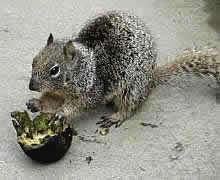 |
|
The City of Ten Thousand Buddhas
The Sagely City of Ten Thousand Buddhas is a unique and rare sanctuary for all living beings.
When I first came to the City in 1990, I was delighted to have arrived at a place where the residents don't deliberately step on ants or kill little creatures that are regarded as pests by most people. The Sagely City is a paradise for anyone who has a sense of appreciation for the plant and animal kingdoms.
The dominant trees in the City of Ten Thousand Buddhas are oak (Quercus lobata), Douglas fir (Pseudotsuga menziesii), and sycamore. The plant life at the City is amazingly abundant and prolific. Many ancient oak trees are found near the main entrance and in the surrounding meadow and the groves. The huge and imposing valley oak in front of the administration office building is said to be several hundred years old. The oak trees have acorns. Whenever I come across an acorn, I recall what George Bernard Shaw expressed in favor of vegetarianism:

Think of the fierce energy concentrated in an acorn! You bury it in the ground, and it explodes into a giant oak. Bury a sheep, and nothing happens but decay.
The tree and I have a lot in common. We share the same earth, air and sun--we are both part of the elements that pervade throughout the universe. Due to past causes and conditions, trees have taken the form of trees, whereas I have entered the human realm. While the tree is fixed to its birthplace for life unless man intervenes and transplants it, I am quite free to move around as I please. The tree provides shade, shelter, and inspiration, and, to me, it is a silent poem of endurance and stillness.

The only tree I know of that has a special religious significance is the Bodhi Tree. The Buddha realized Buddhahood when he sat beneath the Bodhi Tree. The Venerable Master Hua explained that as a result of this, the Bodhi Tree gained great merit and virtue. It is also mentioned in a Sutra that the Buddha lay down on his right side in the auspicious position on a couch between twin sala trees when he entered Nirvana.
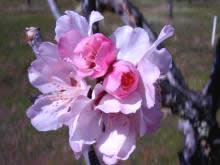

Several flower gardens that bloom during different seasons adorn the Sagely City. There are also vegetable gardens. Different kinds of herbs have been planted in various gardens, while others just grow wild. The leaves of the poison oak turn bright orange or scarlet in the fall and look very beautiful, but they should be avoided. Poison oak teaches us not to be moved when we encounter beautiful forms.
The medicinal herbs are a very special category of plants. They have benefited countless living beings. Since ancient times until today, people have used herbs to maintain health and prevent and cure diseases. The herbs are here to inspire us to quietly cultivate the selfless, magnanimous, and altruistic spirit of the Bodhisattvas.
The Sagely City is like a panoramic, three-dimensional live Sutra, for all the myriad things are indeed speaking the Great Dharma! This dynamic and powerful audio-visual presentation of the Dharma is truly inconceivable, magical, and most wonderful. Peacocks and peahens are a common sight at the City. One can also frequently see grey squirrels scampering about, going up and down the trees, or gnawing away at acorns and nuts.
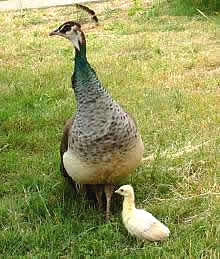

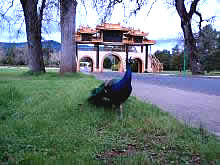
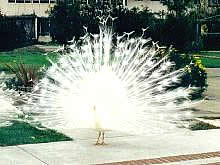
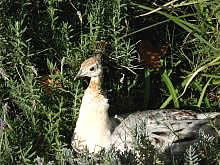
If one walks quietly around the more remote areas of the City, one may occasionally meet up with stags and turkeys. The deer are alert and shy and will run away when they see someone approaching. They are agile and graceful and run in a succession of bounds. They can leap over the fences effortlessly.
Birds are often seen in flight, hovering, gliding, soaring, landing, taking off, walking, or perching on fences, branches, or wire lines.
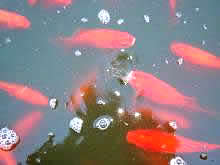

There is a fish pond with aquatic plants next to the Buddha Hall. There is a creek that runs through the Sagely City. Certain sections of it are slow-moving, while others are fast. It usually dries up in the summer and fall. The climatic and seasonal changes which can be observed daily, weekly, monthly, or annually are refreshing and instructive.
In the fall, many trees shed their leaves. As one watches the leaves fall, one is reminded of the fact that the only thing that is permanent in this world is change. Due to the dry spell in summer, when autumn comes, the stretch of pastureland resembles the African savanna.
In the early winter, flocks of birds can be seen flying about. When the rainy season begins, green patches of grass sprout up all over the place. Moss covers the trunks of certain kinds of trees, and lichen is seen hanging from other trees. Many plants bloom and bear fruit in the spring and autumn. Butterflies, birds, and insects can be seen visiting flowers.
Mountain ranges can be seen from many parts of the City of Ten Thousand Buddhas. The rising and setting of the sun can have a spectacular effect on those mountains. During the cold seasons, the fog sometimes covers the mountains partially or completely. When the sun is hidden behind the clouds, it creates a misty, soothing, and solemn atmosphere--very enchanting.

The pure and tranquil atmosphere that pervades the City of Ten Thousand Buddhas is inexpressibly wonderful. Its calming effect is profoundly felt.
The Venerable Master Hsuan Hua, the Founding Patriarch of this "Western Pureland," often said, "Don't go to the mountain of jewels and return empty-handed." The fauna and flora are the external adornments of the Sagely City. If you wish to uncover its hidden treasures, look deeper...



